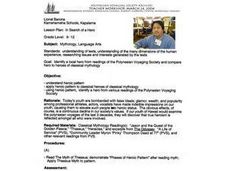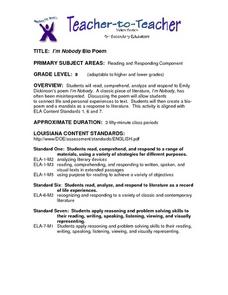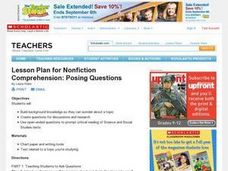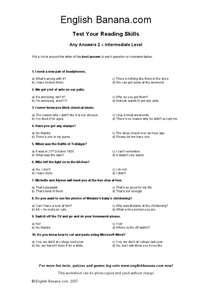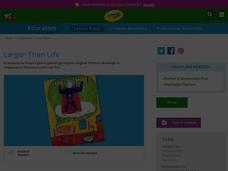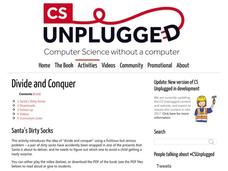Curated OER
Editing Emily's Way: An Exercise in Diction and Its Implications
Learners examine the poetry of Emily Dickinson and the diction in her poetry. In this poetry analysis lesson, students read Dickinson poetry and analyze the diction in the poems. Learners journal about the poetry and rewrite their own...
Curated OER
In Search of a Hero
Students explain heroic pattern and use it to identify heroes from classical mythology and from readings o fthe Polynesian Voyaging Society.
Curated OER
Breaking News English: Disney in Talks to Buy Pixar
In this English worksheet, students read "Disney in Talks to Buy Pixar," and then respond to 1 essay, 47 fill in the blank, 7 short answer, 20 matching, and 10 true or false questions about the selection.
Curated OER
Breaking News English: Disney in Talks to Buy Pixar
In this English instructional activity, students read "Disney in Talks to Buy Pixar," and then respond to 47 fill in the blank, 7 short answer, 20 matching, and 8 true or false questions about the selection.
Curated OER
I'm Nobody Bio Poem
Eighth graders analyze Emily Dickinson's poem, I'm Nobody. After discussing it, they create their own bio poem. They draw and label mandalas and display them in class.
Curated OER
Dr. Seuss Lesson Plan
Students read classic children's books. For this Dr. Seuss lesson, students read the Seuss classics The Cat in the Hat, Green Eggs & Ham and Horton Hears a Who. Students create models based on story characters and discuss the...
Curated OER
Musicians and Vampires
Students practice techniques and strategies for understanding the parts of a story to help them remember what they've read. They review and analyze the elements of a story and how to find them first in a paragraph and then in a book.
Curated OER
Lesson Plan for Nonfiction Comprehension: Posing Questions
Pupils practice writing questions on a selected topic. Students discuss questioning skills. They browse through books and magazines, review their textbooks, watch a film, or participate in a similar experience that will provide some...
Curated OER
April Fool's Day
For this April Fool's Day worksheet, students read or listen to a passage, then match phrases, fill in the blanks, choose the correct words, unscramble words and sentences, write discussion questions and conduct a survey about this day.
Curated OER
Video Games Day
In this video games day worksheet, students read or listen to a passage, then match phrases, fill in the blanks, choose the correct words, unscramble words and sentences, write discussion questions and conduct a survey.
Curated OER
Writing in Different Viewpoints
Students explore different viewpoints through short stories. In this literature instructional activity, students read a classic short story. Students then write a short story from a different point of view.
Curated OER
She or Her?
For this She or Her worksheet, students read 5 paragraphs and circle the correct word (she or her) in 16 different cases. Students also read a brief explanation of the difference between she and her.
Curated OER
Any Answers 2
In this matching questions and comments with appropriate answers worksheet, students read questions, comments, and multiple choice answers, and choose the best answer. Students choose 10 answers.
Curated OER
Cloud Fun
Young scholars observe cumulus clouds. In this weather lesson, students go outside to look at cumulus clouds and observe what the weather is like when they find these types of clouds. They create a cumulus cloud in an art project and...
Curated OER
The Colors of Seasons
Students observe each season and and mark the colors they see. In this colors of the seasons lessons, students read The Mystery of the Missing Hummingbirds and compare their results and note variations of colors in the different...
Curated OER
Order of Events
Read the book The Very Hungry Caterpillar and put the events of the story in order. Each event is written on a sentence strip and while the teacher reads, listeners can arrange the strips inthe correct order. After reading, reshuffle the...
Curated OER
Monomyth Graphic Organizer
Track and explore how the classical concept of the hero's quest is developed in multiple works of literature with a clean and simple graphic organizer. Young readers can fill in the name of any book, movie, or myth and then track their...
Curated OER
Larger Than Life
Learners research the Spanish artist Francisco de Goya and his use of fantasy and allegory in his artwork. After reading either classic or contemporary fantasy stories, they discuss how Goya might have illustrated the stories. Students...
Computer Science Unplugged
Colour by Numbers–Image Representation
How do computers store and send images? Here's an activity that explains one way a computer can compress image information. Pupils decode run-length coding to produce a black and white image. Pairs then work together to code and decode...
Computer Science Unplugged
Conversations with Computers—The Turing Test
Will the real computer please stand up? The premise of this activity is for the class to ask questions to a human and to a computer and to determine which is which. The class asks a given set of questions, and the person playing the role...
Computer Science Unplugged
Divide and Conquer—Santa’s Dirty Socks
The story "Santa's Dirty Socks" provides learners an example of a search algorithm that uses a divide and conquer system similar to a binary search algorithm. The included questions expand upon the concepts that follow the story.
Curated OER
Goldilocks: The Sequel
Students explore their creative-thinking and writing skills while writing a sequel to the classic story, "Goldilocks and the Three Bears". Students work in small groups to complete this activity and share their completed story with the...
Virginia Department of Education
Writing Counterarguments
This activity is better utilized as a peer-editing exercise and not as an activity on how to write counterarguments. Writers take their argumentative rough drafts, peer edit in groups of four, and review the author on common essay...
Curated OER
Ivan the Fool: Lesson 1
Learners read and analyze a classic Eastern European folktale. In partners, they read the story, take notes, define vocabulary terms, and write a summary of the folktale.



